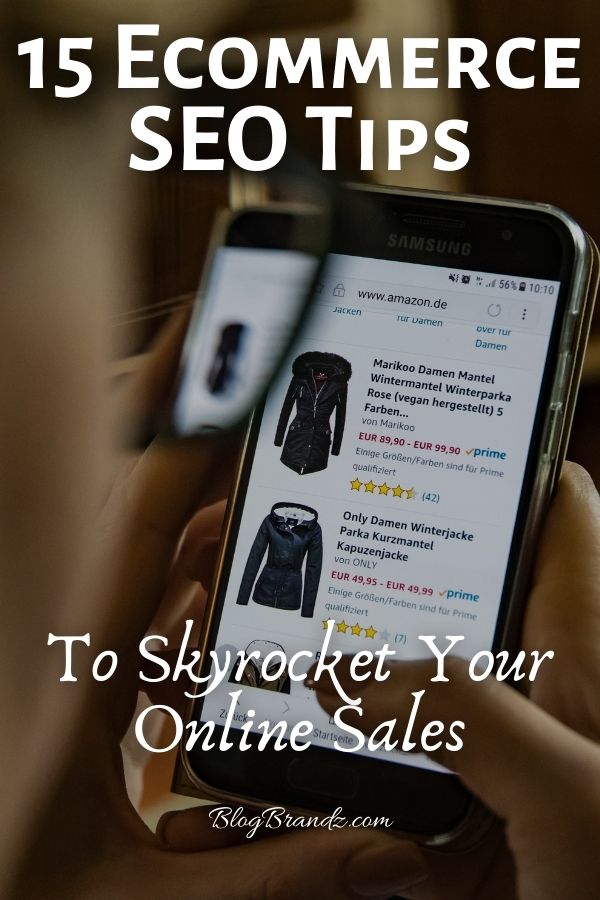Want to improve eCommerce SEO? These 15 eCommerce SEO best practices will help you improve SEO for eCommerce sites and boost your eCommerce website rankings.
SEO is tricky to get right – and SEO for eCommerce websites is even tougher. Ecommerce search engine optimization or eCommerce SEO has a slightly different focus: making sure your products are served to the customers who want them.
To have a fighting chance at beating out the competition, you must implement SEO for eCommerce websites. This means you’ll need to know the best practices to boost your e-commerce SEO.
Contents
- Why Ecommerce SEO?
- 15 eCommerce SEO Best Practices
- 1. Think up product-focused keywords
- 2. Riff keywords and categories from Amazon
- 3. Come up with long-tail keywords
- 4. Get informed about competitor keywords on SEMRush
- 5. Keyword-optimize your URLs
- 6. Avoid keyword cannibalization
- 7. Focus on the most popular pages first
- 8. Get every page within 3 clicks of the homepage
- 9. Embrace sales language to boost product SEO
- 10. Follow the 1000-3 rule for blog content
- 11. Say no to duplicate and thin content
- 12. Don’t forget about regular site speed maintenance
- 13. Get a real link building strategy in place
- 14. Pay close attention to eCommerce SEO on mobile
- 15. Track success and update using e-commerce metrics
- eCommerce Tips & Tutorials
Why Ecommerce SEO?
To buy something online, customers typically go straight to the search bar. In fact, 42% of people start their online shopping with an organic search.
Ecommerce SEO is what helps users find the products they want – even when they don’t yet know what exactly they want.
To successfully sell products online, you’ll need great eCommerce SEO to rank high on Google. You’ll also need it to get ahead of competitors selling similar products.
At the end of the day, eCommerce SEO is how your products rise to the surface of Google’s bottomless results. It’s how you say to users: “Yoo-hoo! I think I’ve got what you what!” Without it, your products may not even be seen, let alone purchased.
15 eCommerce SEO Best Practices
To help you boost your eCommerce website rankings, this article lists 15 best practices for eCommerce SEO that will put your online sales into hyperdrive.
Here are must-have eCommerce SEO best practices so that you can start to build your Google ranking and the user experience on your site.
1. Think up product-focused keywords
Unlike content pages that are focused on giving users the just-right information, your product pages must be skewed towards the way users buy. This is a distinct way of searching – and thinking about SEO.
Both your product and category pages should be optimized for this type of search. Practical phrases that users actually type into Google should be your priority.
How can you come up with great product-focused keywords? Your first step should be to think like a user and focus on the characteristics and target audience of your products.
Let’s say you’re selling athletic shoes. You shouldn’t just add “best athletic shoes.” Make it specific with product and audience information in your keywords, such as “water-proof athletic shoes for women” or “slip-resistant athletic shoes for runners.”
Next, you’ll want to find lexical equivalents for your search. In the case of athletic shoes, you’ll want a variety of keywords that cover synonyms, including sneakers, trainers, tennis shoes, gym shoes, running shoes, etc.
2. Riff keywords and categories from Amazon
If you need an extra hand coming up with keywords, go straight to Amazon. It’s the perfect place to get ideas for keywords and categories.
There are two main ways to make use of Amazon. First, type your product or term in the search bar. Below, a bunch of product keywords will appear that are related to your term.
Second, you can use Amazon’s categories that clearly organize your product. When you drill down from the product category, sub-category, etc., you’ll find useful ideas for structuring your own products.
Pro tip: If you want even more keyword inspiration, Wikipedia’s also a good go-to. In particular, the first sentence of entries is packed with useful keywords, as well as the table of contents.
3. Come up with long-tail keywords
Long-tail keywords are vital for a successful eCommerce SEO strategy. Long-tail keywords are those longer, more specific keywords. SEO gurus, they’re considered the “holy grail” of online marketing.
Users enter long-tail keywords when they have a clear idea of what they want. For this reason, they often have a higher conversion rate. At the same time, these keywords are less competitive because of their specificity. It’s a win-win!
When creating SEO content for eCommerce websites, you should add eCommerce SEO long-tail keywords for all your major projects.
You can decide whether they should be specific to the audience, location, product characteristic, etc. Ideally, they would be as specific as possible without becoming impractical.
4. Get informed about competitor keywords on SEMRush
Another key part of getting eCommerce SEO keywords is understanding your competitors. You’ll want to find out what keywords they’re using, as well as how in-demand and expensive every keyword is.
You can easily get informed by checking out SEMrush’s “Keyword Difficulty” feature. By clicking on this area, you’ll get a list of keywords sorted by how competitive they are, according to competitor sites.
Here you can look for any eCommerce keywords you might have missed, as well as opportunities for those that are low-cost but good fits for your products.
While you’re at it, you can get ideas from competitors by looking at like-competitors in other countries. They’re sure to have some good eCommerce keywords that you hadn’t thought of.
5. Keyword-optimize your URLs
Ecommerce keywords aren’t just for pages either. When doing On-Page SEO for eCommerce websites, you should also optimize your URLs to avoid having product IDs in them.
Instead, they should be short and sweet, ideally with your primary keyword present. Google likes the best URLs that are targeted, without irrelevant characters and underscores. Eliminate any part of the URL that doesn’t specifically define the product keyword(s).
In addition, make sure your URLs aren’t too long. Often URLs are auto-generated with all the categories and subcategories until the product name. Whenever possible, cut out URL filler like this to boost your ranking overall.
6. Avoid keyword cannibalization
Don’t be your own worst enemy. Keyword cannibalization happens when you optimize multiple articles with the same keyword. Essentially this means you’re competing with yourself to get ranked by Google.
When doing On-Page SEO for eCommerce websites, take a good look at your keywords and choose the best-related piece of content for the term. All other content optimized for this keyword should be combined with that piece, recycled under a different keyword, or deleted.
Avoid keyword cannibalization when doing SEO for eCommerce product pages to improve your chances in ranking – and also provide more organized content to your users.
7. Focus on the most popular pages first
The Pareto principle in e-commerce suggests that 80% of sales come from 20% of products. If you’re feeling overwhelmed by optimizing SEO for all your products, start with that 20% chunk first.
These products are the low-hanging fruit that can make the biggest impact in terms of improving ranking and conversion on your site. Identify this 20% and get started on these popular pages. Later, when you have more resources, you can chip away at the remaining products.
At the same time, for product pages that haven’t generated hardly any sales, you should work on cleaning them up. Having too many pages on your website can be a problem for product page SEO because of duplicate content.
Find these low-value pages and then decide which to combine with other pages, delete, or no-index. This will greatly help your eCommerce SEO in the long run.
8. Get every page within 3 clicks of the homepage
One of the golden rules of eCommerce SEO is that every page should be within 3 clicks of the homepage.
If your site architecture requires more clicks to get to every page, it means it’s disorganized. The way your site is structured should be clear to users, with a breakdown of categories and subcategories that makes sense.
Even when you have thousands of pages, your site architecture should be defined from top-to-bottom for the best results. In turn, this will significantly boost your rankings.
9. Embrace sales language to boost product SEO
We don’t typically think sales language has a powerful effect on users – but it does. Your page content, as well as meta info (title tag, description tag, product category, etc.), should use sales language.
Brian Dean at Backlinko recommends the following terms to get better ranking and user interaction:
- X% off (“25% Off”)
- Guarantee
- Lowest Price
- Free Shipping
- Overnight Shipping
- Sale
Try to incorporate these sales terms to boost your eCommerce SEO content. It’s simple yet effective.
10. Follow the 1000-3 rule for blog content
The definition of successful blog content has changed a lot over the years. Nowadays, Google prioritizes long-form content and a balance of keywords.
What does this mean in practice? Basically, your blog content should follow the 1000-3 rule: at least 1,000+ words long with the primary keyword appearing at least 3 times.
Let’s be clear: these are the bare minimums. For content, the longer the better. For keywords, the preferred range runs between 3-5 times. It’s best not to keyword-stuff your content like it’s 2010.
Finally, the placement of your keywords also matters. You should have the keyword present in the introduction to rank higher, for example.
If you use WordPress, a good way to optimize your keyword placement is to use an SEO plugin like Yoast SEO or Rankmath. These plugins will prompt you to improve SEO placement throughout the content.
11. Say no to duplicate and thin content
Ecommerce SEO is plagued by two big issues: duplicate and thin content. This happens often because of the sheer number of product pages on an eCommerce site. But don’t let poor planning get in the way of great content.
When doing SEO for retail websites, duplicate content can be a thorn in your side, especially if your products are similar in nature. Returning to our athletic shoe example of doing SEO for eCommerce products: how much new content can you really write for every pair of shoes on your site?
It’s a daunting task, which is why it’s important to organize your site well. A few tips for duplicate content: create “super pages” that contain multiple products, highlight product differentiators in bullet-point lists and get a blog running to regularly write unique content.
As you resolve duplicate content, you may also suffer from thin content. Thin content is when you fulfill the word count for your pages, but without any real value. It’s the “fluff” of pages that don’t say anything new.
It’s a challenge to get the balance of your product page optimization right, but duplicate and thin content both greatly impact Google rankings. If required, work with an eCommerce SEO services provider to make sure you’re avoiding these extremes.
12. Don’t forget about regular site speed maintenance
By now, everybody knows that site speed is important for Google. But many check their site speed once and then… never think about it again.
To guarantee your site speed, you’ll want to do regular checks to keep it fast. Ecommerce sites are especially prone to slowing down because of the size of the site, as well as the code surrounding payment.
Site speed with eCommerce isn’t easily covered by a plugin either. You’ll need to do constant maintenance checks on your hosting and servers, as well as image files and payment pathways. Do your due diligence on-site speed with regular check-ups.
13. Get a real link building strategy in place
Ecommerce link building is also a key part of eCommerce SEO. Linking to other sites will improve your Google ranking because it shows you’re an authority in the online world.
The best Off-Page SEO for eCommerce websites should include building backlinks for eCommerce sites using guest blogging and building partnerships with SEO blogger outreach.
You may also want to consider the moving man method, where you suggest your pages to other sites with outdated resources, broken links, or new branding as part of link building for eCommerce websites.
When implementing Off-Page SEO for eCommerce websites, you’ll need to get a real eCommerce link-building strategy in place to get a boost in ranking.
14. Pay close attention to eCommerce SEO on mobile
Another good tip for eCommerce SEO is to look at the mobile-specific experience. You may be surprised to discover that half of the eCommerce revenue happens on mobile – and these numbers are growing every year.
That means mobile should be a priority when deciding on the best eCommerce platform for SEO. Your mobile site should integrate all the eCommerce SEO best practices, such as fast site speed and great user experience.
At the same time, you should clean up your content for mobile. Consider short paragraphs that will appear nicely on a cell phone screen.
Your navigation should also be mobile-friendly, with the ability to easily drill down. Your mobile design isn’t the only part of eCommerce SEO optimization, however.
Your mobile SEO should also be focused on strategies such as cutting out unnecessary words in content, deactivating pop-ups, having auto-fill for names and addresses, offering guest check-out, and allowing voice search.
15. Track success and update using e-commerce metrics
Finally, eCommerce SEO is constantly changing. You’ll need to track eCommerce SEO metrics in order to have a clear picture of what’s happening.
Your site should have Google Analytics tracking so you can regularly pull reports and analyze what’s happening with your pages.
With Google Analytics, you can also work to create a dashboard of metrics that you want to check regularly. From these insights, you can then update and tweak your eCommerce SEO as needed.
Doing SEO for eCommerce sites may not be the easiest task in the world. By learning these 15 best practices for eCommerce SEO, you’re one step closer to getting the high-ranked site you deserve.
Remember that SEO is a moving target and doing SEO for an eCommerce site is more complicated than SEO for static websites. It’s important to stay updated with the best eCommerce SEO practices as Google continually updates its SEO ranking system.
And if you’re just getting started with your eCommerce site, be sure to check out my best eCommerce platform post to learn which eCommerce website builder is best for you.
Want to learn how to start an eCommerce business? These free eCommerce guides and online eCommerce courses will show you how.
eCommerce Tips & Tutorials
- Free Ecommerce Guides & Online Ecommerce Courses
- Free Shopify Courses, Shopify Classes & Shopify Training
- How To Sell On Amazon & Start An Amazon FBA Business
- How To Use WooCommerce To Build Online Stores (Almost) Free
- Conscious Shopping Portals And The Growth Of Conscious Commerce
- How To Leverage Social Commerce Platforms For Online Retail
- How To Make Your Own App And Earn Money
© 2021 – 2022, Dale McManus. All rights reserved.
Dale McManus has helped hundreds of thousands of people around the world learn how to create a website over at CreateAProWebsite.com. Whether you want to make a beautiful blog, portfolio, or business website, he’s got you covered with his easy to follow guides and tutorials.
Discover more from Business & Branding Tips
Subscribe to get the latest posts to your email.




